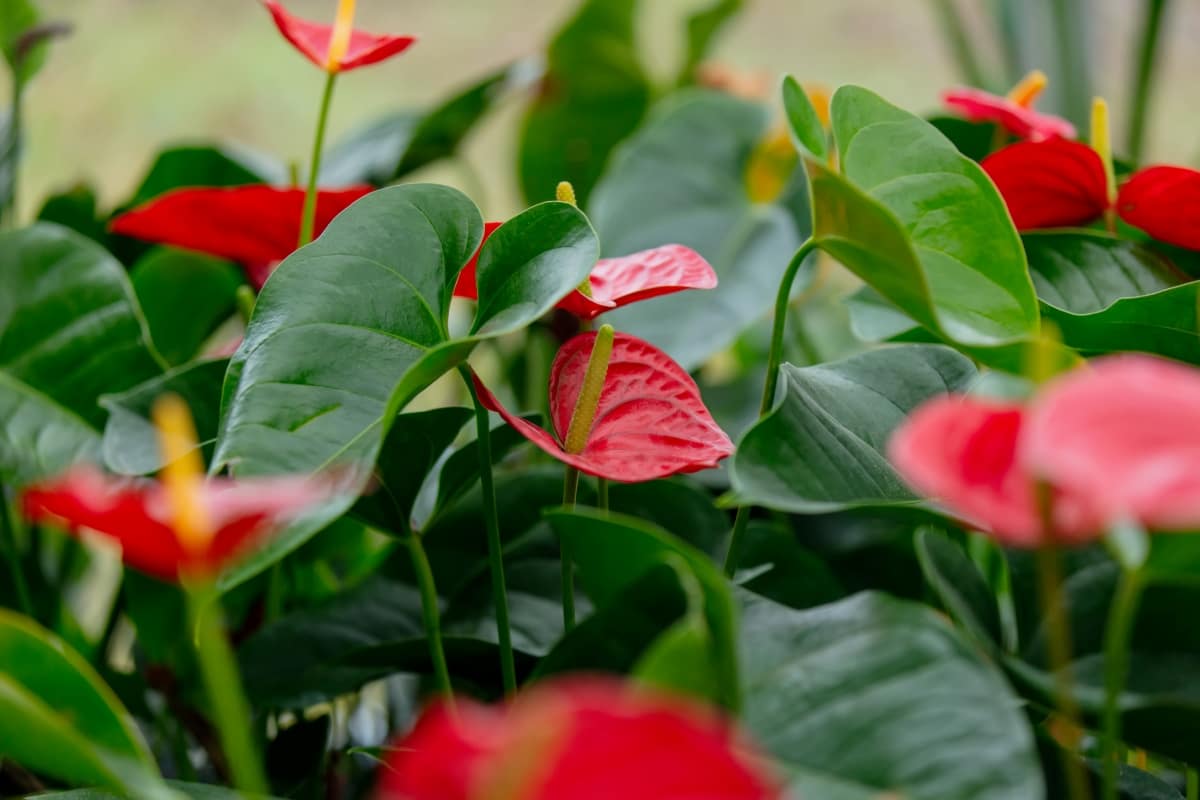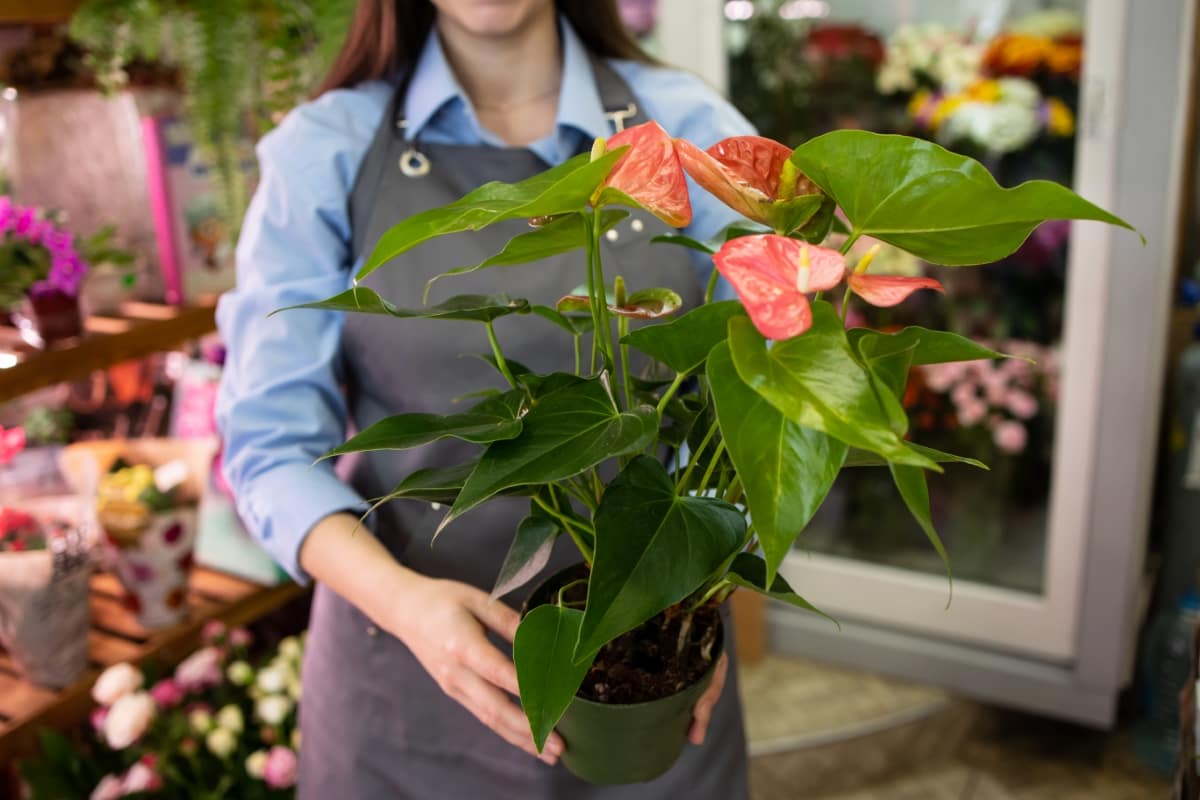Keeping Anthurium plants healthy requires the right fertilizer. The development of foliage and blooms requires a lot of nutrients. Furthermore, plant growth requires a lot of energy. It is, therefore, crucial to add fertilizer specific to indoor plants due to the limited number of nutrients in potting soil. In excess, fertilization can burn a plant’s leaves and roots.

Best Fertilizer for Anthurium
The Role of Fertilizing in Anthurium Plant Health and Growth
The Anthurium needs nutrients to survive, just like all plants. Anthuriums grow in a natural, outdoor habitat when decomposing plants and animals decompose in the soil, producing biomass, which provides them with nutrients and minerals. In contrast, when Anthurium plants are grown indoors, they don’t have access to biomass. To grow healthy plants, you need to provide them with the nutrients they need. Fertilizer is an easy option to do this.
Specific types, amounts, and combinations of nutrients are best for all types of anthurium plants (including rarer species such as Anthurium crystallinum). Furthermore, nutrients must be applied at the right time to ensure the plant grows strong and healthy, helping to control pests and diseases.
Using commercial fertilizers is one of the easiest ways to feed your Anthurium. Nutrients such as nitrogen (N), phosphorous (P), and potassium (K) are contained in these substances, which are essential for plants’ growth and well-being. Magnesium (Mg), Calcium (Ca), and sulfur (S) are also essential macronutrients for plants. The following micronutrients are also needed by plants:
| Boron (B) | Molybdenum (Mo) |
| Chlorine (Cl) | Nickel (Ni) |
| Copper (Cu) | Zinc (Zn) |
| Manganese (Mn) | Iron (Fe) |
A specific combination of macronutrients and micronutrients is necessary for each type of plant to grow well. The amount of these nutrients in commercially prepared fertilizers varies. Fertilizer manufacturers are required to include nutrient analyses on their packaging. Because they are standardized, they are easy to understand.
The Best Fertilizer for Anthurium Plants
A high-phosphorous fertilizer is essential to the growth and bloom of Anthurium plants. The fertilizer packaging will typically display a higher middle number regarding macronutrient ratios. For example, fertilizer with a 10:30:20 ratio contains relatively high phosphorous levels. Dilute it by one-quarter if you use it every four to six weeks (or one-tenth if you use it more often to encourage blooms).
It is best to use a soluble or liquid fertilizer, as these are easy to dilute. The amount of fertilizer can be harder to control when it is granular or slow-release. You can make a homemade formula with fish or chicken bones by boiling them. After the boiled bones have dried, pulverize them in a blender or cut them up finely. After that, work the bone meal into the soil to increase its phosphorus content.
Symptoms Your Anthurium Needs Nutrients and Feeding
Anthurium plants are often epiphytic in their natural habitat – the tropical rainforest. In other words, they grow on plants, trees, and structures. As a result, they don’t require much nutrition to thrive. Your Anthurium may need fertilizer if the foliage is faded or drooping. If the temperature is high, this can also respond, so check that first before adding fertilizer.
In case you missed it: Granular vs Liquid Fertilizer: What’s Best for Corn Farmers

Your Anthurium may have pale leaves in direct sunlight or near a heat source. It may be necessary to apply a highly diluted, balanced fertilizer if this is not the case. Adding fertilizer may help your Anthurium bloom if it isn’t blooming as much as you would like. You can encourage your plant to produce colorful spathes by mixing phosphorus-rich mixtures with water first.
Anthurium Plant Fertilization: When And How Often?
Anthurium plants need to be fertilized only during their active growing season or during the spring and summer months (this is also the best time to prune and repot them if necessary). During this time, fertilizer should be applied every four to six weeks. Avoid fertilizing anthurium plants during the rest of the year (and do not fertilize newly propagated anthurium plants until they have rooted). For more blooms, some recommend applying diluted fertilizer more frequently, such as every other week, down to a tenth strength.
How to Apply Fertilizer
- When applying fertilizer to your Anthurium plant, dilute it to one-quarter strength before applying. You should dilute the fertilizer to about one-tenth strength if you feed more frequently.
- Before you feed your plant, water it the day before. The following day, gently pour the diluted fertilizer around the plant base. Let excess drain from the drainage holes of the pot by pouring slowly.
- When handling Anthurium plants, wearing gloves is prudent because they are somewhat toxic to humans and pets.
Key Considerations When Fertilizing Anthuriums and Treating Overferilized Plants
Generally, over-fertilizing an Anthurium can harm the plant more than under-fertilizing. Overfertilization occurs due to the presence of soluble salts in commercially prepared fertilizers. The soil can accumulate these over time. As a result, plants have difficulty absorbing water. An overfed Anthurium may look similar to an underwatered Anthurium or a plant exposed to too much light.
Symptoms of overfertilization include yellowing or wilted leaves, scorched foliage, and withered stems. It is even possible to cause root rot by applying too much fertilizer. You don’t have to worry if your plant receives too much fertilizer by mistake.
- A potted plant or outdoor plant with a substrate layer of aggregate must have the soil flushed out. Too much fertilizer can, however, burn roots and cause root rot.
- To flush, place the container where the water can drain, such as a sink or bathtub.
- The pot needs to be filled four times with distilled or filtered water (if it’s empty).
- Continue pouring slowly and steadily until you have used all the water, but don’t let the pot overflow.
- After draining the plant for a few hours, return it to its original location.
- A soil change or transplant will work if adequate drainage holes are unavailable, such as when an outdoor plant does not have a substrate.
In case you missed it: Frequently Asked Questions About Homemade Fertilizers

Conclusion
Anthuriums don’t grow fast, even at their happiest, which makes fertilizing them difficult. Nevertheless, they’ll thrive when given the right balance of nutrients to support their growth. For those in temperate climates, give Anthurium frequent, weak fertilizer doses while it is actively growing. To encourage flowering, use a fertilizer higher in phosphorus.
- Feed Your Flock for Less: Top 10 Tips to Save on Chicken Feed
- Ultimate Guide to Ossabaw Island Hog: Breeding, Raising, Diet, and Care
- Hatching Answers: The Top 10 Reasons Your Chickens Aren’t Laying Eggs
- Eggs and Economics: Breaking Down the Cost of Raising Backyard Chickens
- Defend Your Greens: Proven Methods to Keep Iguanas Out of Your Garden
- Ultimate Guide to Cinnamon Queen Chicken: A Comprehensive Guide for Beginners
- Ultimate Guide to California Tan Chicken: Breeding, Raising, Diet, Egg-Production and Care
- Ultimate Guide to Marsh Daisy Chicken: Breeding, Raising, Diet, and Care
- 10 Types of Chicken Farming Businesses You Can Start for Profits